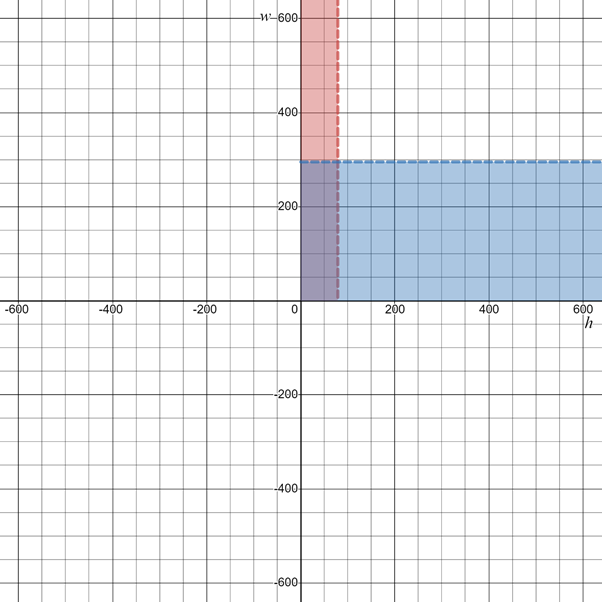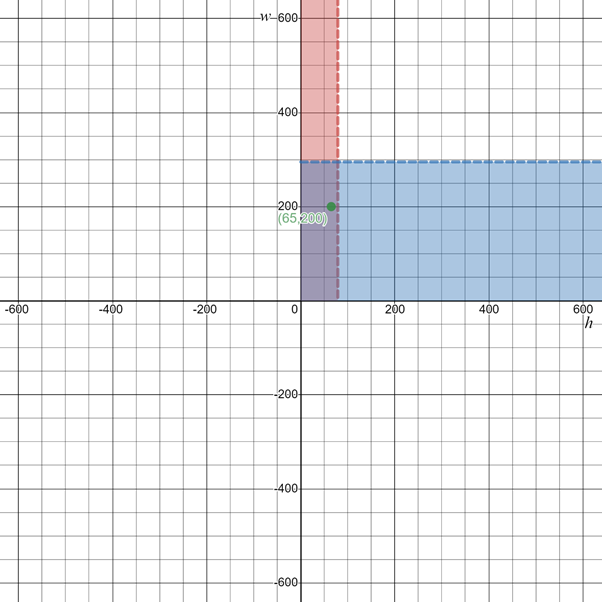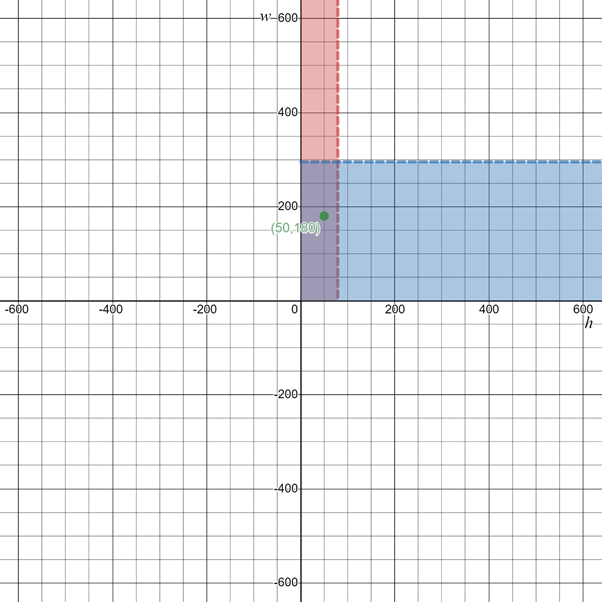
a.
To find:Set of parametric equations.
a.
Answer to Problem 12CT
Explanation of Solution
Given information:
Substitute
We get
The set
b.
To find:Set of parametric equations.
b.
Answer to Problem 12CT
Explanation of Solution
Given information:
Substitute
We get
Therefore, the set
a.
To find: Variables and inequalities and graph of given situation.
a.
Answer to Problem 12CT
Variables are
‘
‘
Inequalities are
Explanation of Solution
Given information:
Height must be under = 6 ft 7 inches.
Weight must be under =295 lb.
We know
1feet =12 inches
Therefore
6 feet 7 inches = 6 feet + 7 inches
=
=
=79 inches
Let ‘
Let ‘
From the given information
Height must be less than 79 inches
Therefore
Weight must be less than 295 lb.
Therefore
Equations-(1) and (2) represents the inequalities of above situation.

Here
Blue colour represents the region of
Red colour represents the region of
Common region of Red colour and Blue colour represent the solution of above inequalities.
b.
To find: One possible solution.
b.
Answer to Problem 12CT
Height = 65 inches.
Weight = 200 lb.
Explanation of Solution
Given information:
Height must be under = 6 ft 7 inches.
Weight must be under =295 lb.
Inequalities are
Graph of given inequalities is

Blue colour represents the region of
Red colour represents the region of
Common region of Red colour and Blue colour represent the solution of above inequalities.
As
c.
To find: Is
c.
Answer to Problem 12CT
Yes.
Explanation of Solution
Given information:
Height must be under = 6 ft 7 inches.
Weight must be under =295 lb.
Graph of given inequalities is

Blue colour represents the region of
Red colour represents the region of
Common region of Red colour and Blue colour represent the solution of above inequalities.
As
Chapter 9 Solutions
Precalculus with Limits: A Graphing Approach
- Use a graphing utility to find the point of intersection, if any, of the graphs of the functions. Round your result to three decimal places. (Enter NONE in any unused answer blanks.) y = 100e0.01x (x, y) = y = 11,250 ×arrow_forward5. For the function y-x³-3x²-1, use derivatives to: (a) determine the intervals of increase and decrease. (b) determine the local (relative) maxima and minima. (e) determine the intervals of concavity. (d) determine the points of inflection. (e) sketch the graph with the above information indicated on the graph.arrow_forwardCan you solve this 2 question numerical methodarrow_forward
- 1. Estimate the area under the graph of f(x)-25-x from x=0 to x=5 using 5 approximating rectangles Using: (A) right endpoints. (B) left endpoints.arrow_forward9. Use fundamental theorem of calculus to find the derivative d a) *dt sin(x) b)(x)√1-2 dtarrow_forward3. Evaluate the definite integral: a) √66x²+8dx b) x dx c) f*(2e* - 2)dx d) √√9-x² e) (2-5x)dx f) cos(x)dx 8)²₁₂√4-x2 h) f7dx i) f² 6xdx j) ²₂(4x+3)dxarrow_forward
- 2. Consider the integral √(2x+1)dx (a) Find the Riemann sum for this integral using right endpoints and n-4. (b) Find the Riemann sum for this same integral, using left endpoints and n=4arrow_forwardProblem 11 (a) A tank is discharging water through an orifice at a depth of T meter below the surface of the water whose area is A m². The following are the values of a for the corresponding values of A: A 1.257 1.390 x 1.50 1.65 1.520 1.650 1.809 1.962 2.123 2.295 2.462|2.650 1.80 1.95 2.10 2.25 2.40 2.55 2.70 2.85 Using the formula -3.0 (0.018)T = dx. calculate T, the time in seconds for the level of the water to drop from 3.0 m to 1.5 m above the orifice. (b) The velocity of a train which starts from rest is given by the fol- lowing table, the time being reckoned in minutes from the start and the speed in km/hour: | † (minutes) |2|4 6 8 10 12 14 16 18 20 v (km/hr) 16 28.8 40 46.4 51.2 32.0 17.6 8 3.2 0 Estimate approximately the total distance ran in 20 minutes.arrow_forwardX Solve numerically: = 0,95 In xarrow_forward
 Calculus: Early TranscendentalsCalculusISBN:9781285741550Author:James StewartPublisher:Cengage Learning
Calculus: Early TranscendentalsCalculusISBN:9781285741550Author:James StewartPublisher:Cengage Learning Thomas' Calculus (14th Edition)CalculusISBN:9780134438986Author:Joel R. Hass, Christopher E. Heil, Maurice D. WeirPublisher:PEARSON
Thomas' Calculus (14th Edition)CalculusISBN:9780134438986Author:Joel R. Hass, Christopher E. Heil, Maurice D. WeirPublisher:PEARSON Calculus: Early Transcendentals (3rd Edition)CalculusISBN:9780134763644Author:William L. Briggs, Lyle Cochran, Bernard Gillett, Eric SchulzPublisher:PEARSON
Calculus: Early Transcendentals (3rd Edition)CalculusISBN:9780134763644Author:William L. Briggs, Lyle Cochran, Bernard Gillett, Eric SchulzPublisher:PEARSON Calculus: Early TranscendentalsCalculusISBN:9781319050740Author:Jon Rogawski, Colin Adams, Robert FranzosaPublisher:W. H. Freeman
Calculus: Early TranscendentalsCalculusISBN:9781319050740Author:Jon Rogawski, Colin Adams, Robert FranzosaPublisher:W. H. Freeman
 Calculus: Early Transcendental FunctionsCalculusISBN:9781337552516Author:Ron Larson, Bruce H. EdwardsPublisher:Cengage Learning
Calculus: Early Transcendental FunctionsCalculusISBN:9781337552516Author:Ron Larson, Bruce H. EdwardsPublisher:Cengage Learning





